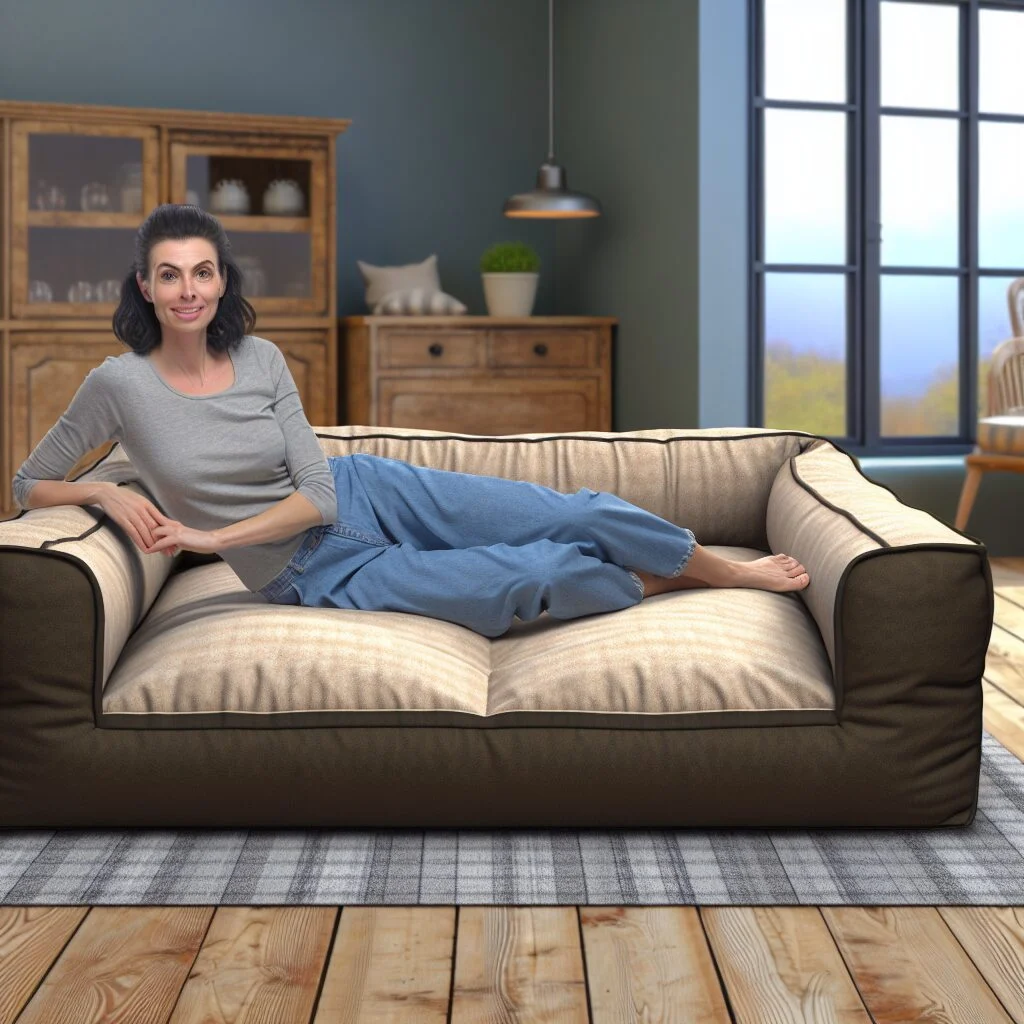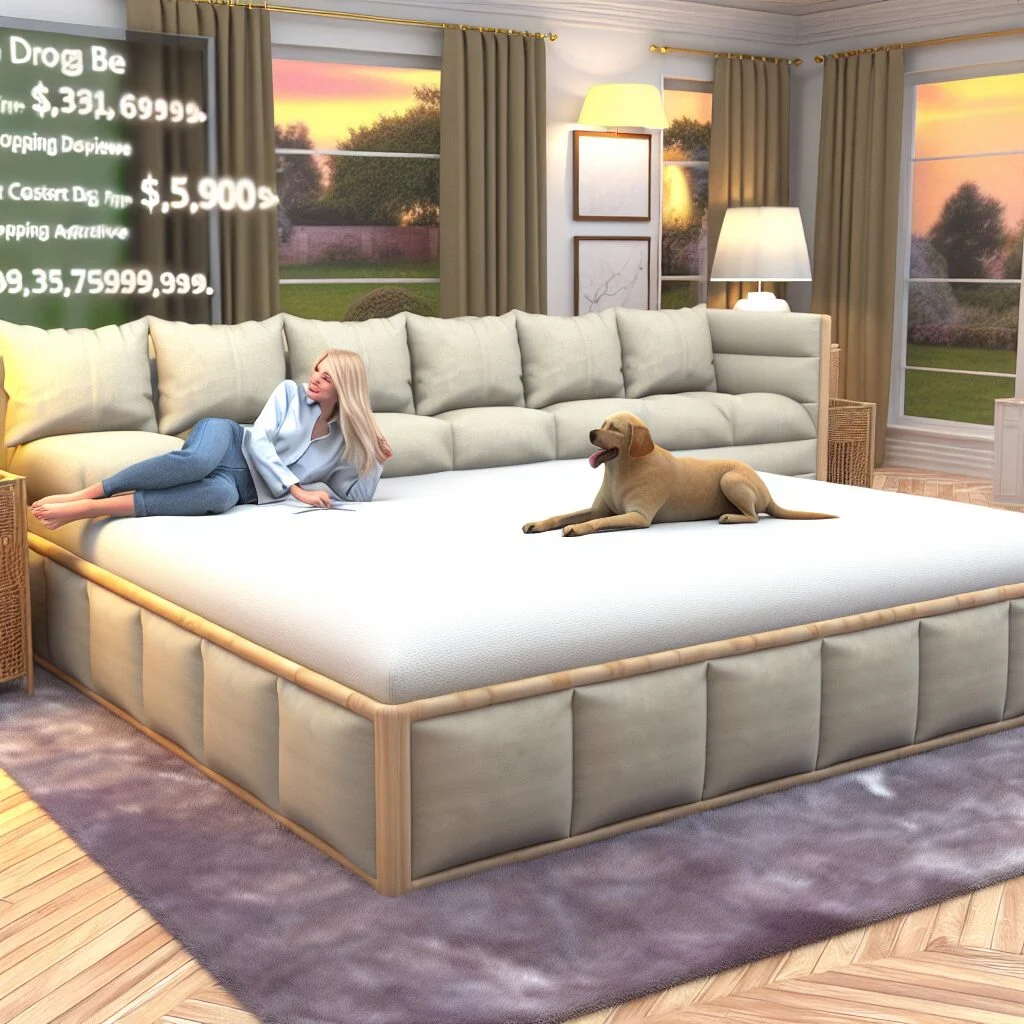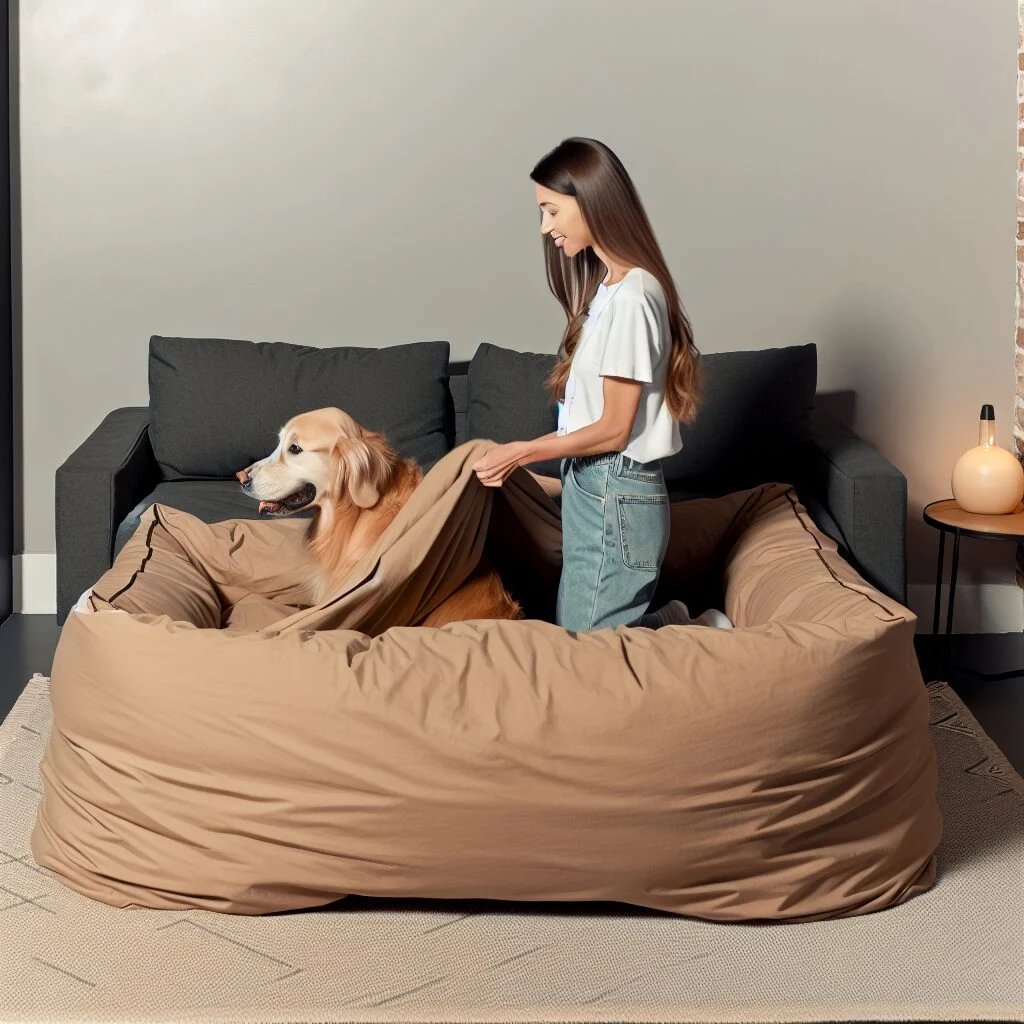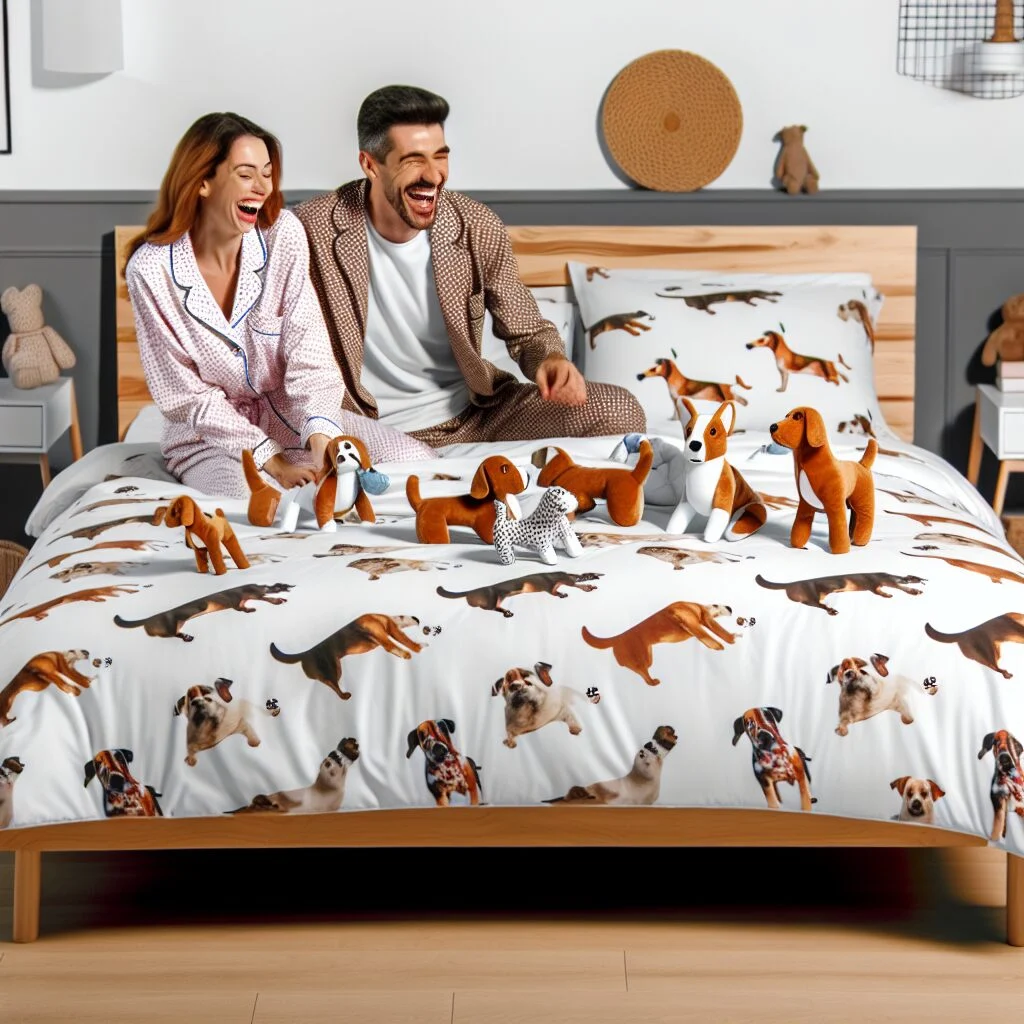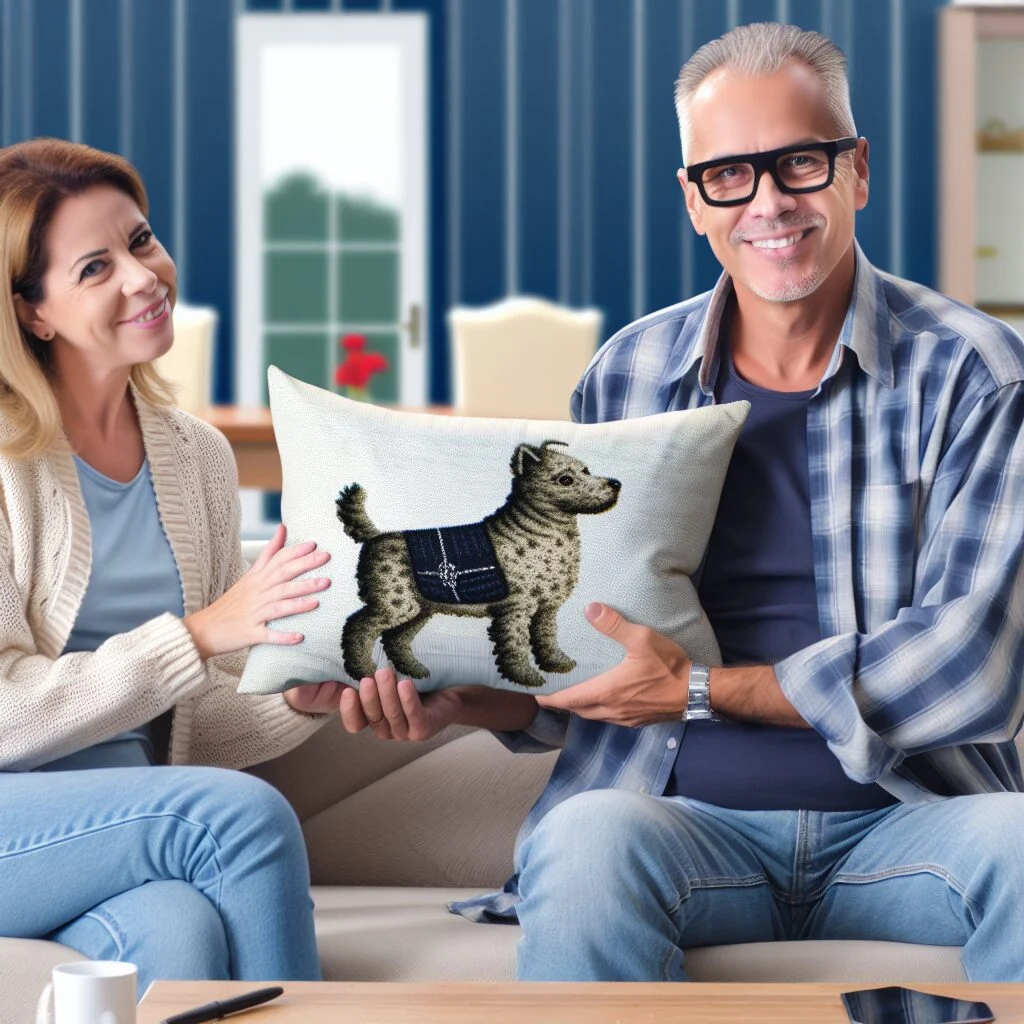Cozy Comfort Reimagined: The Ultimate Guide to Giant Dog Beds for Humans
Ever found yourself eyeing your pet’s plush bed with a twinge of envy? You’re not alone. The trend of giant dog beds designed for human use has been gaining significant traction in recent years, offering an innovative approach to relaxation that combines the best aspects of bean bags, floor cushions, and traditional mattresses. These oversized, ultra-plush lounging spaces are revolutionizing how we think about comfort and rest in our homes. In this comprehensive guide, we’ll explore everything you need to know about giant dog beds for humans – from their unique benefits to the best models on the market, where to find them, and even how to create your own custom version.
What Exactly Are Giant Dog Beds for Humans?
Giant dog beds for humans are exactly what they sound like – oversized, plush lounging areas inspired by the classic dog bed design but scaled up for human use. These cozy havens typically feature thick foam padding surrounded by bolstered edges that create a nest-like environment, enveloping users in comfort from all sides. Unlike traditional furniture, these beds sit directly on the floor, offering a unique lounging experience that’s perfect for reading, napping, meditating, or simply unwinding after a long day.
The concept may sound quirky at first, but it addresses a fundamental human desire for comfort and security. There’s something inherently soothing about being surrounded by soft, cushioned walls – it creates a sense of being embraced and protected that many people find deeply relaxing. This innovative furniture piece blends the boundary between pet accessories and human furniture, creating a versatile addition to any home that can be enjoyed by everyone, including your four-legged family members.
Why Choose a Giant Dog Bed Over Traditional Furniture?
Unmatched Comfort for Relaxation
The primary appeal of human-sized dog beds is their exceptional comfort level. Unlike conventional sofas or beds that might have firm edges or rigid frames, these oversized cushions provide a fully padded experience with no hard surfaces. The surrounding bolsters create the perfect support for your back, neck, and limbs, allowing you to sink into a truly ergonomic position whether you’re sitting upright or lying down.
Many users report that these beds offer relief for various body aches and pains. The foam typically used in quality models conforms to your body, distributing weight evenly and reducing pressure points that can cause discomfort during extended periods of rest. For those who enjoy floor sitting or have difficulty getting comfortable on traditional furniture, these beds offer an alternative that may better align with their natural posture preferences.
Versatile Use for Multiple Activities
One of the most appealing aspects of giant dog beds for humans is their versatility. These multifunctional pieces can serve numerous purposes throughout your home:
- Reading nook: The supportive bolsters create the perfect backrest for extended reading sessions
- Meditation space: The cushioned environment is ideal for mindfulness practices
- Movie watching: More comfortable than floor pillows but more casual than formal seating
- Guest sleeping option: Many models are large enough to accommodate overnight guests
- Workspace alternative: For those who prefer floor sitting while working on laptops
- Kids’ play area: Children are naturally drawn to these cozy spots for playing, reading, or napping
- Pet bonding: Large enough to share with your four-legged friends for quality time together
Their portable nature also means they can be moved from room to room as needed, unlike heavier furniture pieces, making them adaptable to changing household needs.
Space-Saving Solution
Despite their generous proportions, these beds can actually save space in smaller homes or apartments. Because they sit directly on the floor, they have a lower profile than traditional couches or beds, making rooms feel more spacious. Many models can be compressed or folded when not in use, allowing for easy storage – something that’s impossible with conventional furniture.
For studio apartments, tiny homes, or multipurpose rooms, a giant dog bed can serve as both seating and sleeping space without dominating the room visually the way a bed frame or couch might. This versatility makes them particularly appealing for those looking to maximize functionality in limited square footage.
Top Models and Where to Buy Giant Dog Beds for Humans
The market for human-sized dog beds has expanded significantly in recent years, with several standout brands offering unique takes on this innovative concept. Here’s a comprehensive look at some of the leading options available for purchase:
Plufl: The Original Human Dog Bed
Often credited with popularizing the trend, Plufl has become synonymous with high-quality human dog beds. Their signature product features premium orthopedic and memory foam with a plush, machine-washable cover. The Plufl measures approximately 68 inches long by 38 inches wide, making it spacious enough for most adults to stretch out comfortably.
What sets Plufl apart is their attention to ergonomic design. The bolsters are strategically positioned to support various lounging positions, and the thickness of the base foam (around 3-4 inches) provides substantial cushioning without losing support. Plufl beds are available directly from their website and can also be found on major retailers like Amazon, typically priced between $399-$499 depending on current promotions.
Human Nest: Luxury Oversized Options
For those seeking an even more spacious option, Human Nest offers some of the largest models on the market. Their signature bed measures an impressive 74.8 inches by 47.3 inches with nearly 14 inches of height in the bolsters, providing ample room for even tall individuals to stretch out fully. The removable, machine-washable faux fur cover offers a luxurious tactile experience that many users find particularly comforting.
Human Nest models typically incorporate multiple layers of foam with varying densities to provide an optimal balance of support and softness. These premium options usually retail between $500-$700, reflecting their larger size and high-end materials.
Budget-Friendly Alternatives
For those interested in trying the concept without investing in a premium model, several more affordable alternatives have emerged on marketplace sites like Amazon and Wayfair. These beds typically range from $200-$350 and, while they may not offer the same level of durability or specialized foam as higher-end options, they provide a good entry point to experience the comfort of a human dog bed.
When shopping for budget alternatives, pay close attention to dimensions and foam quality, as some less expensive models may use thinner padding or smaller overall dimensions that might not accommodate adults comfortably. Look for options with removable, washable covers, as this feature significantly extends the lifespan and hygiene of the product.
Special Sales and Discounts
Giant dog beds for humans often see significant price reductions during major shopping events. Memorial Day, Black Friday, and end-of-season sales frequently feature discounts of 15-30% on these items. Subscribing to manufacturer newsletters can be a good strategy for catching these limited-time offers.
Additionally, many manufacturers offer discount codes for first-time buyers or for signing up for their email list, potentially saving you $50-$100 on your purchase. Some brands like Plufl occasionally offer refurbished or slightly imperfect models at reduced prices, providing another avenue for savings.
Choosing the Right Giant Dog Bed for Your Needs
With various options available, selecting the perfect giant dog bed involves considering several key factors to ensure you find one that meets your specific requirements:
Size Considerations
The appropriate size depends on your height and how you intend to use the bed. For reference:
- Standard models (approximately 68″ x 38″): Suitable for individuals up to 5’10” who primarily plan to lounge or curl up
- Oversized models (approximately 75″ x 47″): Better for taller individuals or those who want to fully stretch out
- Extra-large models (80″+ in length): Ideal for sharing with partners or multiple pets
Remember to consider the dimensions of the room where you’ll place the bed. Measure your available floor space beforehand to ensure a comfortable fit without overcrowding the area.
Material and Construction Quality
The materials used in a giant dog bed significantly impact both comfort and longevity. Here are the key components to evaluate:
- Foam quality: Look for high-density foam (at least 3-4 inches thick) for adequate support. Memory foam or orthopedic foam options provide better pressure relief but tend to come at a higher price point.
- Cover material: Common options include faux fur, microfiber, and various plush fabrics. Consider your preference for texture, warmth, and how the material will complement your home décor.
- Removable covers: This feature is essential for easy cleaning. Check whether covers are machine washable and how they secure to the foam base (zippers tend to be more durable than velcro closures).
- Bolster construction: Examine how the bolsters are filled and attached. They should be firm enough to provide support but soft enough for comfort.
Quality construction typically manifests in even stitching, reinforced seams, and thoughtful design features like non-slip bottoms or handles for repositioning the bed.
Special Features Worth Considering
Manufacturers continue to innovate with features that enhance the functionality and comfort of human dog beds:
- Water-resistant or waterproof liners: Particularly valuable if you plan to share the bed with pets or small children
- Cooling materials: Some models incorporate gel-infused foam or breathable covers to regulate temperature
- Customizable filling: Beds that allow you to add or remove filling to adjust firmness
- Integrated blankets or pillows: All-in-one solutions that include matching accessories
- Portability features: Carrying handles or compression straps for easier movement and storage
These additional features may increase the initial investment but can significantly enhance your overall experience with the product.
DIY Options: Creating Your Own Custom Giant Dog Bed
For those with a creative streak or specific requirements not met by commercial options, creating a DIY human dog bed can be a rewarding project that allows complete customization of size, materials, and aesthetics.
Basic Materials and Tools Needed
To create your own human-sized dog bed, you’ll need to gather these essential materials:
- Foam: High-density upholstery foam (3-5 inches thick) for the base and bolsters
- Fabric: Approximately 5-7 yards of durable upholstery fabric, depending on bed size
- Batting: Polyester batting for added softness
- Zipper: Heavy-duty zipper for creating a removable cover
- Thread: Strong upholstery thread
- Cutting tools: Scissors, utility knife, or electric knife for foam cutting
- Measuring tools: Tape measure and straight edge
- Sewing machine: Heavy-duty sewing machine capable of handling thick fabrics
Optional materials include waterproof fabric liner, non-slip material for the bottom, and decorative trims or embellishments to personalize your creation.
Step-by-Step Construction Process
While a detailed tutorial would require specific measurements based on your individual needs, here’s a general overview of the construction process:
- Design and measure: Sketch your design and determine dimensions based on the intended user’s height and preferred sleeping position.
- Cut foam pieces: You’ll need one large rectangular base piece and typically 3-4 bolster pieces to create the raised edges.
- Create patterns: Using paper or cardboard, create patterns for each fabric piece needed (base cover, bolster covers, bottom panel).
- Cut fabric: Cut out all fabric pieces according to your patterns, adding seam allowances.
- Sew bolster covers: Create tube-like covers for each bolster piece with one end left open for inserting the foam.
- Assemble base cover: Sew the base cover with a zipper along one edge for removability.
- Insert foam: Place foam pieces into their respective covers.
- Connect components: Attach bolsters to the base cover through sewing or other secure fastening methods.
- Add finishing touches: Install non-slip material on the bottom if desired and add any decorative elements.
For those without sewing skills or access to a machine, alternative construction methods include using heavy-duty fabric glue, furniture staples with a wooden base, or even repurposing existing cushions and securing them together in the desired configuration.
Cost-Saving Tips and Material Alternatives
Creating your own giant dog bed can be more economical than purchasing a premium model, but costs can still add up quickly. Here are some strategies for keeping your DIY project budget-friendly:
- Repurpose existing materials: Old memory foam mattress toppers can be cut down for the base, and pillows can be repurposed for bolster filling.
- Shop sales and remnants: Upholstery shops often sell foam remnants at reduced prices. Fabric stores frequently offer significant discounts on end-of-bolt fabrics.
- Consider alternative fillings: While high-density foam provides the best support, alternatives like shredded foam, polyester fiber fill, or even bean bag filling can work for those on tighter budgets.
- Simplify the design: A basic rectangular shape with fewer bolsters requires less material and simpler sewing than more complex designs.
- Use drop cloths or durable bedsheets: Canvas drop cloths or high-thread-count sheets can serve as budget-friendly fabric alternatives for covers.
By being resourceful with materials, a DIY human dog bed can be created for approximately $100-200, compared to $400-700 for premium commercial options.
Living with Your Giant Dog Bed: Maintenance and Care
To maximize the lifespan and maintain the hygiene of your giant dog bed, proper care is essential. These practical tips will help keep your investment in optimal condition for years of comfortable use.
Cleaning and Hygiene
Regular maintenance is key to ensuring your giant dog bed remains fresh and sanitary:
- Weekly maintenance: Vacuum the surface using an upholstery attachment to remove hair, dust, and debris.
- Washing removable covers: Most covers can be machine washed every 2-4 weeks, depending on usage. Always follow the manufacturer’s washing instructions regarding water temperature and drying methods.
- Spot cleaning: For minor spills, immediately blot (don’t rub) with a clean, damp cloth and mild soap if needed.
- Deodorizing: Between washes, sprinkle baking soda on the surface, let it sit for 15-20 minutes, and vacuum thoroughly to neutralize odors.
- Deep cleaning: For beds without removable covers, cleaning services that specialize in upholstery can provide professional deep cleaning annually.
If you share your bed with pets, consider using a washable blanket as an additional protective layer that can be laundered more frequently than the main cover.
Extending the Lifespan of Your Bed
With proper care, a quality giant dog bed can last 3-5 years or longer. These practices help preserve its structure and comfort:
- Rotating the bed: Periodically rotate the bed 180 degrees to distribute wear evenly, especially if you tend to favor one section.
- Avoiding direct sunlight: Prolonged exposure to sunlight can degrade foam and fade fabric covers. Position your bed away from windows or use window treatments to block direct sun.
- Managing moisture: Foam can develop mold if it remains damp. If the inner foam becomes wet, ensure it dries completely before replacing the cover.
- Supporting the structure: When sitting on the bed, distribute your weight rather than consistently pressing on one bolster, which can cause premature flattening.
- Storage considerations: If storing the bed temporarily, keep it in a clean, dry place in its natural flat position rather than folded, which can create permanent creases in the foam.
For DIY beds, consider creating an additional outer cover that’s easy to remove and wash, extending the life of the primary cover and protecting the foam core.
Integrating Your Giant Dog Bed into Your Home Decor
A giant dog bed for humans is a substantial piece that will become a focal point in any room. With thoughtful planning, it can enhance rather than detract from your overall home aesthetic.
Ideal Placement in Various Room Types
Finding the perfect spot for your oversized lounger requires considering both function and flow:
- Living rooms: Position against a wall to create a cozy reading nook, or float it near other seating to incorporate it into conversation areas.
- Bedrooms: Place at the foot of the bed for an additional lounging space, or in a corner to create a relaxation zone separate from the main sleeping area.
- Home offices: A giant dog bed can offer a comfortable alternative to desk seating for creative thinking or phone calls with the right support pillows.
- Media rooms: These beds make excellent informal seating for movie watching when positioned with a clear view of the screen.
- Sunrooms or enclosed porches: The casual nature of these beds pairs well with indoor-outdoor spaces, creating inviting relaxation zones.
Consider traffic patterns when positioning your bed—allow enough space for people to walk around it comfortably while ensuring it doesn’t obstruct doorways or access to other furniture.
Coordinating with Existing Decor
The substantial size of a giant dog bed means its appearance will significantly impact your room’s aesthetic. These strategies help it become a cohesive element of your design:
- Color coordination: Choose a cover color that either complements or thoughtfully contrasts with your existing color scheme. Neutral tones (gray, beige, cream) blend easily with most decors, while bold colors can create an intentional accent.
- Texture consideration: The texture of your bed can enhance your room’s tactile experience. Plush velvet or faux fur adds luxury to modern spaces, while canvas or linen works well in more casual, rustic environments.
- Accessorizing: Add coordinating throw pillows or a matching blanket to tie the bed visually to other elements in the room.
- Custom covers: For seamless integration, consider having additional covers made in fabrics that specifically match or complement your existing upholstery.
Remember that these beds can serve as a statement piece. Embracing their unique character rather than trying to disguise them often results in more successful design integration.
Seasonal Adaptations
One advantage of giant dog beds with removable covers is the ability to refresh your space seasonally:
- Summer options: Lighter fabrics like cotton or linen in cooler colors create an airy feel.
- Winter coziness: Faux fur, velvet, or microplush covers in deeper tones add warmth and comfort during colder months.
- Seasonal accessories: Change throw pillows or add seasonal throws to update the look throughout the year without replacing the entire cover.
Having multiple covers not only extends the life of each one but also provides design flexibility that keeps your space feeling fresh and intentional.
The Social Phenomenon: Why Giant Dog Beds Are Trending
The rising popularity of human-sized dog beds reflects broader cultural shifts in how we think about comfort, home design, and lifestyle priorities.
Social Media Influence and Celebrity Adoption
Like many contemporary trends, giant dog beds for humans gained significant traction through social media platforms. Instagram and TikTok have been particularly influential channels, with content creators showcasing these oversized loungers in stylishly designed spaces. Viral videos of people unboxing and testing these beds have generated millions of views, introducing the concept to audiences worldwide.
Several celebrities and social media influencers have embraced the trend, further elevating its profile. Their endorsements have helped legitimize what might otherwise be seen as a quirky niche product, positioning giant dog beds as aspirational lifestyle items rather than novelties. The visual appeal of these beds—their plush, inviting appearance and distinctive silhouette—makes them naturally photogenic additions to curated social media feeds.
Changing Concepts of Home Comfort
The surge in interest also reflects evolving attitudes about home comfort and functionality. Traditional furniture conventions are increasingly giving way to more personalized, comfort-focused approaches. Several factors contribute to this shift:
- Remote work revolution: As more people work from home, there’s greater emphasis on creating versatile, comfortable spaces that serve multiple functions.
- Wellness focus: Increased attention to mental wellbeing has led many to create dedicated relaxation zones in their homes.
- Casual living: Formal living spaces are becoming less common, replaced by more approachable, comfort-oriented environments.
- Pet relationships: The deepening bond between humans and pets has blurred the boundaries between pet accessories and human furniture.
Giant dog beds for humans embody this evolution, offering a novel solution that prioritizes physical comfort and emotional wellbeing over conventional furniture traditions.
User Experiences and Testimonials
The enduring appeal of these oversized loungers is perhaps best understood through the experiences of those who use them. Common themes emerge from user reviews and testimonials:
“I was skeptical at first, but my Plufl has become my favorite spot in the house. I struggle with anxiety, and there’s something incredibly soothing about being surrounded by softness on all sides. It’s like a weighted blanket for your entire body.” – Jamie T.
“Our giant dog bed has become the most fought-over spot in our living room. The kids do homework there, my husband reads there, I meditate there, and yes, our two dogs think it’s theirs too. Best purchase we’ve made for our home in years.” – Samantha K.
“As someone with chronic pain, finding comfortable positions can be challenging. The supportive foam and adjustable bolsters of my human dog bed allow me to find relief in ways traditional furniture never could.” – Michael R.
These testimonials highlight how giant dog beds address fundamental human needs for comfort, security, and flexibility in ways that conventional furniture often cannot match.
Looking Forward: The Evolution of Giant Dog Beds for Humans
As this innovative furniture category continues to grow, manufacturers are exploring new variations and enhancements to meet diverse consumer needs.
Emerging Trends and Innovations
The market is evolving rapidly with several notable trends:
- Smart features: Some manufacturers are beginning to incorporate heating elements, massage functions, or even built-in speakers into their designs.
- Eco-friendly materials: Responding to consumer demand, more companies are offering options made from sustainable materials like organic cotton covers, recycled polyester fill, or plant-based foam alternatives.
- Modularity: Newer models feature modular designs that can be reconfigured into different shapes or even combined with additional units for larger lounging areas.
- Outdoor versions: Weather-resistant materials and specialized construction techniques are making it possible to bring the comfort of giant dog beds to patios, decks, and other outdoor environments.
- Specialized therapeutic options: Models designed specifically for users with particular health conditions or physical needs are beginning to emerge in the market.
These innovations suggest that giant dog beds are evolving from novelty items into sophisticated comfort solutions that address specific lifestyle requirements.
Final Thoughts: Is a Giant Dog Bed Right for You?
While not for everyone, a human-sized dog bed might be an excellent addition to your home if you value:
- Alternative relaxation spaces beyond conventional furniture
- Versatile pieces that can adapt to multiple uses
- Comfort solutions that accommodate floor-sitting or unconventional resting positions
- Creating shared spaces where you can relax alongside pets
- Statement pieces that express personality and prioritize comfort over convention
As with any significant purchase, consider your specific needs, available space, and how you’ll integrate this unique piece into your daily life before investing. For many users, the unusual comfort and versatility these beds provide justifies stepping outside traditional furniture conventions.
Whether you choose a premium manufactured model, a budget-friendly alternative, or embark on creating your own custom design, a giant dog bed for humans represents a reimagining of personal comfort that challenges our assumptions about how furniture should look and function in our homes. As these innovative pieces continue to evolve, they offer an intriguing glimpse into a future where furniture design is increasingly focused on adaptability, comfort, and wellness rather than traditional forms and functions.
Frequently Asked Questions About Giant Dog Beds for Humans for Sale
What size giant dog bed should I buy for an adult human?
For most adults, look for beds at least 68 inches long and 38 inches wide. Taller individuals (over 5’10”) should consider larger options around 75 inches long by 47 inches wide. The height of the bolsters should be approximately 12-14 inches to provide adequate support. Always check the manufacturer’s dimensions before purchasing to ensure it will accommodate your height and preferred lounging position.
Where can I buy a quality giant dog bed for humans?
Quality giant dog beds for humans can be purchased from several sources. Premium brands like Plufl offer direct purchasing through their websites. Amazon carries various options including the popular Plufl and Human Nest brands. Home goods retailers like IKEA and Target have begun offering similar products, though they may not be explicitly labeled as “dog beds for humans.” For custom options, platforms like Etsy feature artisan-made versions. Watch for sales during major shopping events like Memorial Day, Black Friday, and end-of-season clearance periods for potential discounts.
How much should I expect to spend on a giant dog bed for humans?
Price ranges vary based on size, materials, and brand positioning. Budget-friendly options typically range from $200-$350, though these may use simpler materials and construction. Mid-range beds from established brands like Plufl generally cost $399-$499. Premium oversized models with luxury materials and additional features can range from $500-$700. DIY alternatives can be created for approximately $100-$200 in materials if you have the necessary skills and tools. Many manufacturers offer discount codes for first-time buyers that can save 10-15% off regular pricing.
Are giant dog beds for humans comfortable for sleeping overnight?
While primarily designed for lounging and napping, many users do find giant dog beds comfortable for occasional overnight sleeping. Models with thicker bases (4+ inches of foam) provide better support for extended use. The bolstered edges create a nest-like environment that many people find conducive to restful sleep. However, they typically don’t offer the same level of support as a proper mattress and may not be ideal for those with specific orthopedic needs or for permanent nightly sleeping arrangements. They make excellent guest sleeping options or alternatives for those who occasionally enjoy floor sleeping.
How do I clean and maintain a giant dog bed for humans?
Most quality giant dog beds feature removable, machine-washable covers that should be laundered every 2-4 weeks depending on use. Follow manufacturer’s specific washing instructions regarding water temperature and drying methods. For regular maintenance, vacuum the surface weekly using an upholstery attachment. Spot clean minor spills immediately by blotting with a clean, damp cloth. For odor control between washes, sprinkle baking soda on the surface, let it sit for 15-20 minutes, then vacuum thoroughly. Protect the foam core from moisture, as dampness can lead to mold development. Extending the bed’s lifespan involves rotating it periodically, keeping it out of direct sunlight, and avoiding sitting consistently in one spot, which can flatten the foam over time.
Can I make my own giant dog bed for humans instead of buying one?
Yes, creating your own giant dog bed is definitely possible and can be more economical than purchasing a premium model. You’ll need high-density upholstery foam (3-5 inches thick), durable fabric (5-7 yards depending on size), polyester batting, a heavy-duty zipper, and appropriate tools including measuring implements and a sewing machine. The basic construction involves creating a large rectangular base with raised bolsters around the edges. For those without sewing skills, alternatives include using heavy-duty fabric glue, furniture staples with a wooden base, or repurposing existing cushions. Cost-saving strategies include using foam remnants from upholstery shops, repurposing memory foam mattress toppers, and utilizing end-of-bolt fabric discounts. Detailed tutorials can be found online for specific measurements and step-by-step instructions based on your desired dimensions and design.
